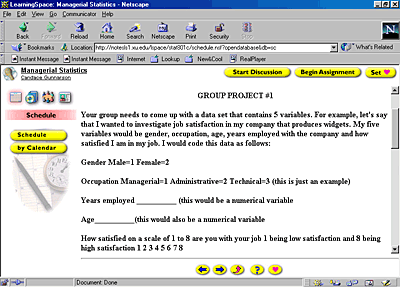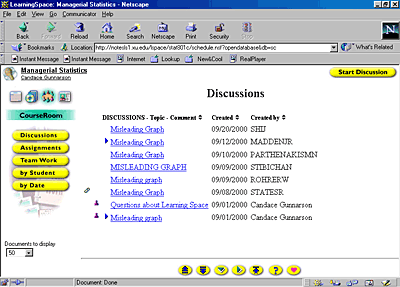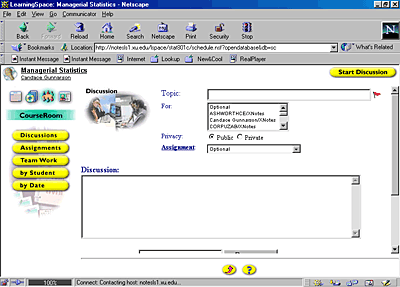| 1. | Introduction |
| 2. | The Statistics Course |
| 3. | The Online Course Design |
| 4. | The Participants |
| 5. | The Study |
| 6. | Findings |
| 7. | Conclustions |
| 8. | References |
![]()
Development and Assessment
of Students: Attitudes and Achievement in a Business Statistics Course Taught
Online
Candace
L. Gunnarsson, Xavier University
Abstract
This paper
is a report on the development and assessment of a graduate level statistics
course taught in an online setting. Students taking the newly developed
statistics course online were compared to students taking the course in
a traditional classroom. Achievement along with three mediating variables
was investigated. The three mediating variables included: prior computer
experience, prior math knowledge and experience, and attitude toward the
subject of statistics. The participants were forty-two graduate students
in their first year of the MBA program. Students' attitudes toward learning
in an online environment were favorable. Differences were found in their
attitude toward the subject of statistics and prior computer experience;
however, no causal relationship in achievement was detected. Students
who learned in an online environment achieved comparably to students learning
in a traditional classroom
1. Introduction
Web based
instruction is becoming a convenient and popular means to higher education.
Currently, mainstream institutions of higher learning are taking initiatives
to dramatically improve the technological relevance of their curriculum.
Course offerings utilizing web-based instruction are multiplying at unprecedented
rates.
Although there are many examples of web-based courses, it is now clear
that much more is involved than just presenting the components of a conventional
course via the Internet (Kahn, 1997). Lectures are not improved by posting
them on a web site and discussions do not automatically happen when students
are connected to a mailing list or computer bulletin board.
As with any new technology, we are often drawn to the technology itself rather than recognizing technology as a tool to enhance learning. When a course is delivered in an online environment, old roles between student and teacher and student and subject become redefined and new roles emerge. Issues involving equity of access, the needs of the learner, and the role of teacher as tour guide and site facilitator emerge.
With any college course, the mode of delivery and the design of the course content can make the difference between a learning experience that is truly excellent and an experience that is considered fair or even poor. This holds true for online learning as well. As online educators, we cannot simply utilize new technology; we must be sure that it is accessible to all students and that it truly enhances learning.
![]()



